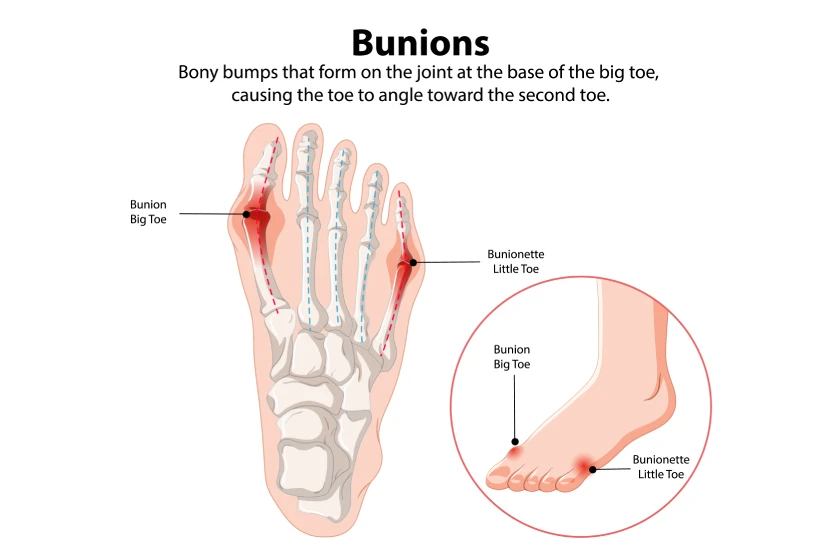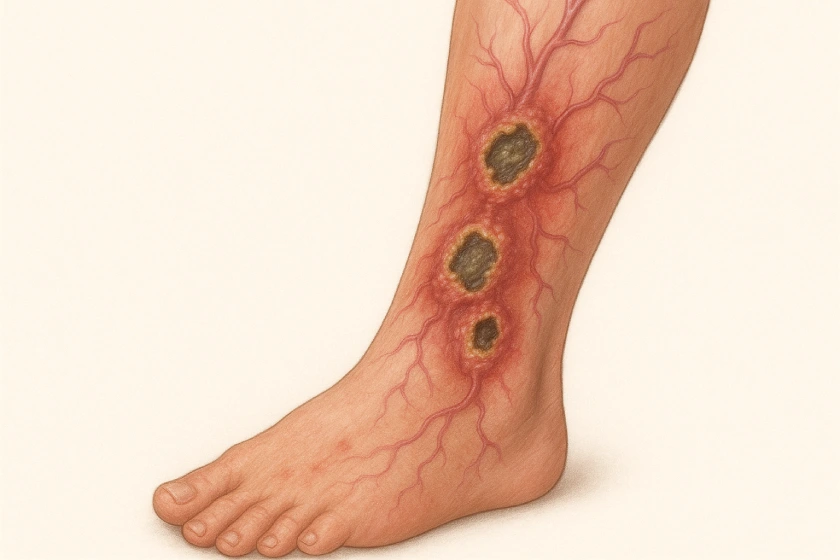What Are Bunions? Causes, Symptoms, and Stages Explained
If you’ve ever noticed a bony bump at the base of your big toe that aches or rubs against your shoes, you might be dealing with a bunion. Bunions are more than just cosmetic concerns; they can cause chronic discomfort, difficulty walking, and joint deformities if left untreated.
Understanding the causes, symptoms, and stages of bunions on the feet is essential for early intervention and effective bunion treatment. Whether you’re exploring bunion correction without surgery or considering a visit to a bunion surgery centre, knowing your options can make all the difference in finding relief and restoring comfort.
What Are Bunions?
A bunion, medically known as hallux valgus, is a structural deformity that forms when the big toe gradually leans toward the smaller toes, causing the base joint to protrude outward. This misalignment leads to a visible bump on the side of the foot, often accompanied by swelling, redness, and pain.
Over time, the deformity can worsen, making it difficult to wear certain shoes or walk comfortably. While many people assume bunions are caused solely by footwear, they are often influenced by genetics, foot shape, and biomechanical imbalances.
Causes of Bunions
The causes of bunions can vary from person to person, but several common factors contribute to their development:
Key services include:
- Genetic Predisposition: Bunions often run in families, as foot shape and structure are hereditary. If your parents or grandparents had bunions on their feet, you might be more likely to develop them.
- Improper Footwear: Tight, pointed, or high-heeled shoes can push the toes out of alignment, accelerating the deformity.
- Biomechanical Issues: Flat feet, excessive pronation, or arthritis can alter how you walk, placing uneven pressure on your toe joint.
- Injury or Overuse: Repetitive strain or trauma to the toe joint can contribute to bunion formation.
- Underlying Medical Conditions: Disorders like rheumatoid arthritis or neuromuscular diseases can weaken ligaments and joints, increasing bunion risk.
Understanding these causes helps determine the right foot bunion treatment, from preventive bunion exercises to corrective procedures.
Symptoms of Bunions
The bunion symptoms may begin subtly but tend to progress over time. Early detection can prevent long-term discomfort and complications.
Common symptoms include:
- A bony bump on the side of the big toe joint
- Swelling, redness, or tenderness around the area
- Pain while walking or wearing shoes
- Corns or calluses where the toes overlap
- Restricted movement of the big toe
If you’re experiencing persistent discomfort, using a bunion corrector or engaging in regular bunion exercises may help relieve early pain and prevent worsening.
Stages of Bunions
Bunions typically develop in stages. Understanding these can help determine the right bunion treatment at each phase.
Stage 1: Mild
The big toe starts leaning slightly toward the smaller toes. You may notice mild redness or swelling, but little to no pain.
Treatment tip: Use a bunion corrector or the best bunion corrector in India to realign the joint and prevent further progression. Early bunion exe
Stage 2: Moderate
The bump becomes more visible, and pain begins to appear during walking or while wearing tight shoes.
Treatment tip: Orthotic insoles, toe spacers, and bunion correction without surgery can help manage symptoms and slow progression.
Stage 3: Severe
The deformity becomes pronounced, often causing overlapping toes and chronic pain. At this stage, non-surgical options provide limited relief.
Treatment tip: You may need to consult a bunion surgery centre for evaluation. Minimally invasive bunion surgery can restore alignment and relieve pain.
Stage 4: Chronic or Postural Changes
If left untreated, severe bunions can alter your gait and cause pain in other areas, like the knees or hips.
Treatment tip: Surgical intervention is often the only effective solution, followed by proper footwear and physiotherapy during bunion surgery recovery.
When to See a Doctor
You should consult a specialist if you experience:
- Persistent foot pain that limits your activities
- Difficulty wearing shoes due to swelling or deformity
- Numbness, tingling, or stiffness in the big toe
- Recurring corns or calluses caused by misalignment
At this stage, professional evaluation helps determine whether conservative management or surgical correction is needed. Clinics offering foot bunion treatment can recommend the best course of action, from bunion corrector devices to advanced bunion surgery.
If surgery is required, choosing a trusted bunion surgery center ensures precision, safety, and a smooth bunion surgery recovery. Post-surgery rehabilitation often includes custom footwear and guided bunion exercises to restore mobility.
Conclusion
Bunions are not just a cosmetic problem; they are a progressive condition that affects balance, comfort, and overall foot health. Early attention can make a world of difference.
From preventive care with the best bunion corrector in India to comprehensive bunion treatment plans, managing bunions on the feet requires a proactive and personalised approach.
Whether you’re seeking bunion correction without surgery or preparing for bunion surgery, remember that timely care, expert consultation, and consistent follow-up are key to long-term comfort and mobility.
FAQs
What causes bunions?
Bunions are primarily caused by genetic factors, improper footwear, and biomechanical imbalances. They develop when the big toe joint moves out of alignment due to repeated pressure or structural weakness.
Are bunions hereditary?
Yes, bunions often run in families. If you inherit certain foot types, like flat feet or low arches, you’re more prone to developing bunions.
Do medical conditions lead to bunions?
Certain conditions, such as arthritis, connective tissue disorders, and neuromuscular diseases, can contribute to bunion formation by weakening the foot’s ligaments and joints.
Can bunions be prevented?
While genetics can’t be changed, prevention is possible through proper footwear, regular bunion exercises, and early use of a bunion corrector. Maintaining healthy foot alignment can also reduce the need for bunion surgery later on.




